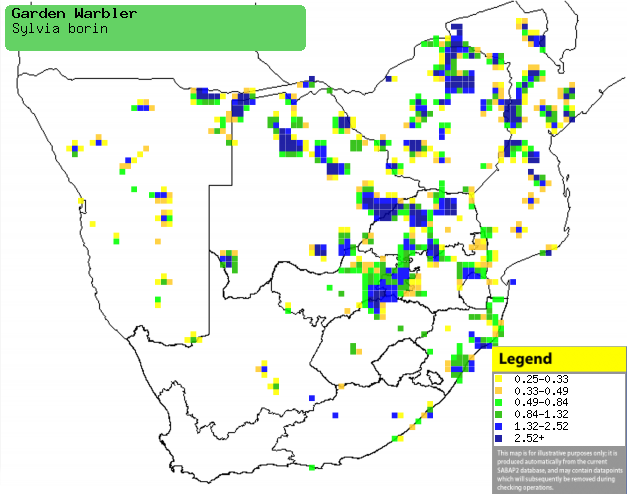|
Sylvia borin (Garden
warbler)
Tuinsanger [Afrikaans]; Niini (generic term for
warblers and eremomelas) [Kwangali]; Soamahlaka-sa-jarete [South Sotho];
Timba (generic name for cisticolas and warblers) [Shona]; Tuinfluiter
[Dutch]; Fauvette des jardins [French]; Gartengrasmücke [German];
Felosa-das-figueiras [Portuguese]
Life
> Eukaryotes >
Opisthokonta
> Metazoa (animals) >
Bilateria >
Deuterostomia > Chordata >
Craniata > Vertebrata (vertebrates) > Gnathostomata (jawed
vertebrates) > Teleostomi (teleost fish) > Osteichthyes (bony fish) > Class:
Sarcopterygii (lobe-finned
fish) > Stegocephalia (terrestrial
vertebrates) > Tetrapoda
(four-legged vertebrates) > Reptiliomorpha > Amniota >
Reptilia (reptiles) >
Romeriida > Diapsida > Archosauromorpha > Archosauria >
Dinosauria
(dinosaurs) > Saurischia > Theropoda (bipedal predatory dinosaurs) >
Coelurosauria > Maniraptora > Aves
(birds) > Order: Passeriformes
> Family: Sylviidae > Genus: Sylvia
Distribution and habitat
Its breeding grounds stretch from Europe to Russia; in the
non-breeding season it head south to much of sub-Saharan Africa, only excluding
parts of Ethiopia and Somalia. In southern Africa it is locally common in
habitats with dense vegetation, such as forest edges, thickets in woodland,
moist coastal bush and well-wooded gardens and parks.
|
 |
|
Distribution of Garden warbler in southern Africa,
based on statistical smoothing of the records from first SA Bird Atlas
Project (©
Animal Demography unit, University of
Cape Town; smoothing by Birgit Erni and Francesca Little). Colours range
from dark blue (most common) through to yellow (least common).
See here for the latest distribution
from the SABAP2. |
Movements and migrations
It arrives in southern Africa from
September-November, staying until about March-April.
Food
It eats a variety of invertebrates and fruit, doing most of
its foraging in the undergrowth, gleaning prey from leaves and twigs and
occasionally hawking an insect. The following food items have been recorded
in its diet:
- Invertebrates
- Fruit
- Parinari curatellifolia (Mobola-plum)
- Canthium (turkey-berries and rock alders)
- Morus (mulberries)
- figs
- Ficus burkei (Common wild fig)
- Lantana camara (Cherry pie)
Threats
Not threatened.
References
-
Hockey PAR, Dean WRJ and Ryan PG 2005. Roberts
- Birds of southern Africa, VIIth ed. The Trustees of the John Voelcker
Bird Book Fund, Cape Town.
|
